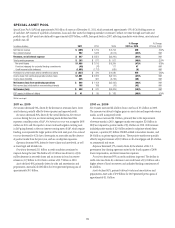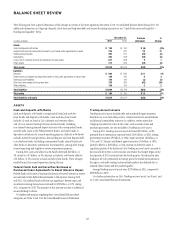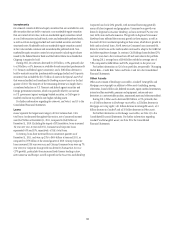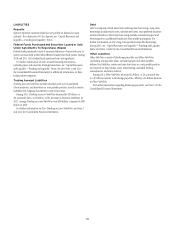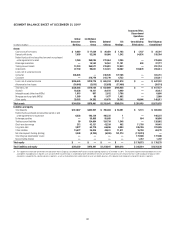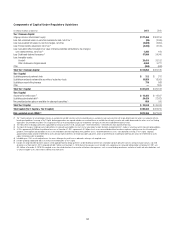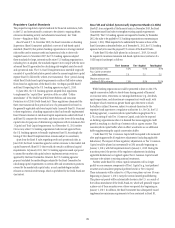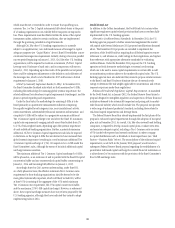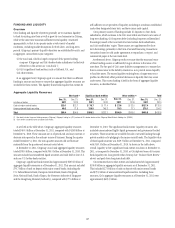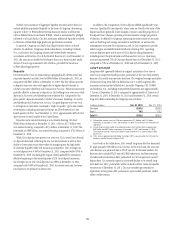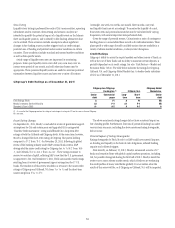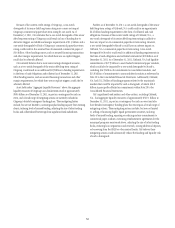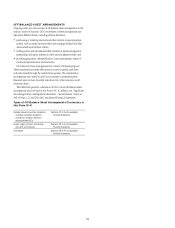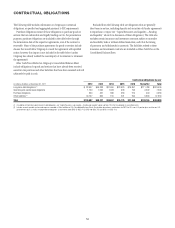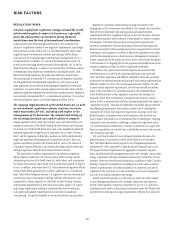Citibank 2011 Annual Report Download - page 67
Download and view the complete annual report
Please find page 67 of the 2011 Citibank annual report below. You can navigate through the pages in the report by either clicking on the pages listed below, or by using the keyword search tool below to find specific information within the annual report.
45
Regulatory Capital Standards
The prospective regulatory capital standards for financial institutions, both
in the U.S. and internationally, continue to be subject to ongoing debate,
extensive rulemaking activity and substantial uncertainty. See “Risk
Factors—Regulatory Risks” below.
Basel II and II.5. In November 2005, the Basel Committee on Banking
Supervision (Basel Committee) published a new set of risk-based capital
standards (Basel II) that permits banking organizations to leverage internal
risk models used to measure credit and operational risks to derive risk-
weighted assets. In November 2007, the U.S. banking agencies adopted
these standards for large, internationally active U.S. banking organizations,
including Citi. As adopted, the standards require Citi to comply with the most
advanced Basel II approaches for calculating risk-weighted assets for credit
and operational risks. The U.S. Basel II implementation timetable originally
consisted of a parallel calculation period under the current regulatory capital
regime (Basel I), followed by a three-year transitional “floor” period, during
which Basel II risk-based capital requirements could not fall below certain
floors based on application of the Basel I rules. Citi began parallel Basel I
and Basel II reporting to the U.S. banking agencies on April 1, 2010.
In June 2011, the U.S. banking agencies adopted final regulations
to implement the “capital floor” provision of the so-called “Collins
Amendment” of The Dodd-Frank Wall Street Reform and Consumer
Protection Act of 2010 (Dodd-Frank Act). These regulations eliminated the
three-year transitional floor period in favor of a permanent floor based on
the generally applicable risk-based capital rules (currently Basel I). Pursuant
to these regulations, a banking organization that has formally implemented
Basel II must calculate its risk-based capital requirements under both Basel I
and Basel II, compare the two results, and then use the lower of the resulting
capital ratios for purposes of determining compliance with its minimum Tier
1 Capital and Total Capital requirements. As of December 31, 2011 neither
Citi nor any other U.S. banking organization had received approval from
the U.S. banking agencies to formally implement Basel II. Accordingly, the
timing of Citi’s Basel II implementation remains subject to uncertainty.
Apart from the Basel II rules regarding credit and operational risks, in
June 2010, the Basel Committee agreed on certain revisions to the market risk
capital framework (Basel II.5) that would also result in additional capital
requirements. In January 2011, the U.S. banking agencies issued a proposal
to amend the market risk capital rules to implement certain revisions
approved by the Basel Committee. However, the U.S. banking agencies’
proposal excluded the methodologies adopted by the Basel Committee for
calculating capital requirements on certain debt and securitization positions
covered by the market risk capital rules, as such methodologies include
reliance on external credit ratings, which is prohibited by the Dodd-Frank Act
(see below).
Basel III and Global Systemically Important Banks (G-SIBs)
Basel III. As an outgrowth of the financial crisis, in December 2010, the Basel
Committee issued final rules to strengthen existing capital requirements
(Basel III). The U.S. banking agencies are required to finalize, by December
2012, the rules to be applied by U.S. banking organizations commencing on
January 1, 2013. While expected to be substantially the same as those of the
Basel Committee as described below, as of December 31, 2011, the U.S. banking
agencies had yet to issue the proposed U.S. version of the Basel III rules.
Under Basel III, when fully phased in on January 1, 2019, Citi would
be required to maintain minimum risk-based capital ratios (exclusive of a
G-SIB capital surcharge) as follows:
Tier 1 Common Tier 1 Capital Total Capital
3TATEDæMINIMUMæRATIOæ æ
0LUSæ#APITALæCONSERVATIONæ
BUFFERæREQUIREMENT æ
%FFECTIVEæMINIMUMæRATIOæ
WITHOUTæ'3)"æSURCHARGE
While banking organizations would be permitted to draw on the 2.5%
capital conservation buffer to absorb losses during periods of financial
or economic stress, restrictions on earnings distributions (e.g., dividends,
equity repurchases, and discretionary compensation) would result, with
the degree of such restrictions greater based upon the extent to which
the buffer is utilized. Moreover, subject to national discretion by the
respective bank supervisory or regulatory authorities (i.e., for Citi, the U.S.
banking agencies), a countercyclical capital buffer ranging from 0% to
2.5%, consisting of only Tier 1 Common Capital, could also be imposed
on banking organizations when it is deemed that excess aggregate credit
growth is resulting in a build-up of systemic risk in a given country. This
countercyclical capital buffer, when in effect, would serve as an additional
buffer supplementing the capital conservation buffer.
Under Basel III, Tier 1 Common Capital will be required to be measured
after applying generally all regulatory adjustments (including applicable
deductions). The impact of these regulatory adjustments on Tier 1 Common
Capital would be phased in incrementally at 20% annually beginning on
January 1, 2014, with full implementation by January 1, 2018. During the
transition period, the portion of the regulatory adjustments (including
applicable deductions) not applied against Tier 1 Common Capital would
continue to be subject to existing national treatments.
Further, under Basel III, certain capital instruments will no longer
qualify as non-common components of Tier 1 Capital (e.g., trust preferred
securities and cumulative perpetual preferred stock) or Tier 2 Capital.
These instruments will be subject to a 10% per year phase-out over 10 years
beginning on January 1, 2013, except for certain limited grandfathering.
This phase-out period will be substantially shorter in the U.S. as a result of
the Collins Amendment of the Dodd-Frank Act, which will generally require
a phase-out of these securities over a three-year period also beginning on
January 1, 2013. In addition, the Basel Committee has subsequently issued
supplementary minimum requirements to those contained in Basel III,


